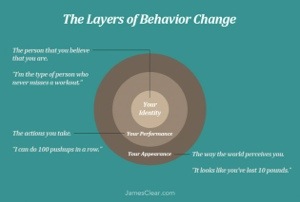What to Do When Setting Goals Gets You Nowhere
Having a good sense of yourself is critical to successful goal-setting. Not only does it allow you to create reasonable expectations, but you’re more likely to have long-term success with new habits that are rooted in your identity. That’s the theory from entrepreneur and behavioral science writer James Clear.
What does that mean exactly? In a recent post, Clear explained by describing the three layers of behavior change: your identity, your performance, and your appearance.
“A lot of people, when they set a goal for themselves they take some type
of performance- or appearance-based goal to go after, like lose 20 pounds in six weeks. Or in the case of running, ‘I’m going to run this half marathon at the end of May,’” Clear told Inc.
“The problem with this is–it’s fine if you want to just go ahead and finish the race–but often it won’t build a long-term habit because there’s no shift in the underlying identity of the person.”
Providing a more personal example, Clear explained that for years he had struggled to write consistently even though he wanted to. Typically, he’d only publish when he was feeling particularly inspired or was on a deadline.
So he decided to take a more structured approach, and he experimented with different habits. He tried writing once a month. Then he tried writing five days a week. Eventually he settled on writing two days a week — on Monday and Thursday — and the habit stuck.
“Maybe a year or so in, it shifted. I’m not just writing every Monday and Thursday because I need to put another article out,” Clear said. “I’m doing it because I’m a writer now.”
It’s Counterintuitive, But It Works
The overall theory might seem counterintuitive. How can you form successful identity-based habits if your striving toward a new identity?
The answer, Clear said, lies in the fact that the two are closely tied. You can use those habits to gradually shift your underlying identity, just as he did when he transitioned to becoming a writer.
“The only way I know to make that shift, to create that type of identity change, is to focus on a bunch of tiny behaviors and just repeat them over and over again. And eventually, that repetition leads to a change in identity,” he explained.
This process applies to professional as well as lifestyle goals. First, think about the outcome you want to achieve. Then, rather than focusing on what that result looks like, focus on the actions that already successful people have taken to get that result.
“So a classic business example could be, I want to land a $10,000 client. Or I want to make $1 million in sales,” Clear said. “Instead of focusing on that result, how about waking up and becoming the type of person who makes one sales call every morning? Or the type of person who reaches out to 25 new people each week?”
“You focus on becoming that type of person and trust that the results follow naturally,” he said.
Written by Laura Montini for Inc.

